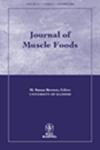COMPARISON OF METHODS TO VERIFY END POINT COOKING TEMPERATURE OF CHANNEL CATFISH (ICTALURUS PUNCTATUS) FILLETS
Abstract
ABSTRACT
Cooking to 63C for 15 s remains an important step to ensure safe fish for human consumption. Methods for heat process verification have not been validated for channel catfish (Ictalurus punctatus). The present research compared extractable protein quantification, lactate dehydrogenase, acid phosphatase and catalase activity assays for verification of internal cooking temperature of channel catfish fillets. Ground raw catfish fillet samples (fresh and frozen) were cooked to 55, 60, 62, 63, 64 and 66C. Extractable protein, acid phosphatase and catalase activities decreased as internal cooking temperature increased, but lactate dehydrogenase activity remained unchanged. Samples cooked to 63C had extractable protein concentrations between 9.11 and 10.02 mg/g (95% confidence). Catalase was rapidly inactivated between 55 and 60C and may be suitable for identification of severely undercooked product. Acid phosphatase activity was influenced by method of storage (fresh versus frozen). A method based on total extractable protein appeared to be the most promising for determining the end point cooking temperature of catfish.
PRACTICAL APPLICATIONS
The most precise and reliable method to verify maximum cooking temperature attained during heat treatment of catfish fillets was total extractable protein. This finding may be useful for critical control point verification and may be valuable where claims of foodborne illness associated with catfish consumption are being litigated or investigated. To confirm gross undercooking, an easier test would be to measure catalase activity.

 求助内容:
求助内容: 应助结果提醒方式:
应助结果提醒方式:


